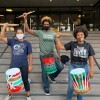California Spent Nearly $1 Billion To Boost Arts Education. How Are Schools Spending It?

Stay up-to-date with free briefings on topics that matter to all Californians. Subscribe to CalMatters today for nonprofit news in your inbox.
Thanks to Proposition 28, California’s K-12 schools are awash in nearly $1 billion in new arts funding. But a coalition of nearly 100 arts groups says that some school districts may be misspending the money, deepening longstanding inequities in arts education.
"The intent of Prop. 28 is to have more arts in schools," said Abe Flores, deputy director of policy and programs at Create CA, which advocates for arts education in California. "We’re concerned that’s not happening everywhere. If people found out one school was offering math, for example, and another school wasn’t, they’d be outraged. That’s what’s happening with the arts."
Prop. 28, which voters passed overwhelmingly in 2022, gives schools an additional 1% of their budgets annually for visual arts, theater, dance, music or media arts. The windfall came after decades of underfunding that left many students with little or no arts education at all, except where parent donations covered the costs. At the time the measure passed, barely 1 in 5 schools had a full-time art or music teacher, with low-income schools more likely to be affected.
Schools are supposed to spend 80% of the money on staff and 20% on materials and report to the California Department of Education annually on how they’re spending the money.
But because of budget uncertainties — in part due to the end of federal pandemic relief funds — some school districts are considering accounting maneuvers that undermine the intent of the initiative, Flores said. Prop. 28 requires schools to expand arts offerings, but some districts are planning to use their funds to pay for existing positions and programs and re-allocate the additional money elsewhere, which the coalition says violates the initiative’s "clear and plain language."
"Prop. 28 states that schools must expand their arts programs," Flores said. "It does not say they can backfill. It’s pretty clear."
The coalition is asking the state to require school districts to prove they’ve hired more arts teachers and draw up expenditure plans for the future. They also want more community input and transparency, because currently the state doesn’t require schools to post their Prop. 28 expenditure plans or include families or the community in planning efforts.
Elizabeth Sanders, a spokesperson for the Department of Education, said an independent auditor will review schools’ Prop. 28 spending, and if the auditor finds that schools are misusing their money they risk losing state funds.
"We are aware of allegations of misuse of Prop. 28 funds and we take any misuse of state funds very seriously," Sanders said. "We’re not here to supplant the independent auditor process, but we do want to make sure we’re sharing as many resources as possible so districts can be in compliance with the law."
The state is offering webinars, convening an advisory council and posting information online to help districts navigate the new funding.
What if a School Already Has a Robust Arts Education Program?
Modoc Joint Unified, in far northeastern California, is among the districts struggling with the Prop. 28 spending requirements. In fact, the district hasn’t spent a dime of its $134,000 allotment, in part because it already has a robust arts program, Superintendent Tom O’Malley said. The 800-student district has a full-time music teacher in the elementary school and a dozen arts classes in the high school, including jazz and concert band, choir, ceramics, printmaking and Advanced Placement art. A local community theater provides drama instruction. Half the high school students are enrolled in some kind of arts class.
Right now, the money is just sitting there, which is very frustrating when we have all these other needs.Tom O’Malley, Superintendent
But even if it needed an arts teacher, hiring one would be nearly impossible, O’Malley said. The district — located in the high plains 146 miles from the nearest city — already struggles to fill its teacher vacancies. The elementary school had seven open teacher positions (of 24 total) at the beginning of the school year, and this year couldn’t open its transitional kindergarten class because it had no teacher.
Meanwhile, the school buildings, some of which are nearly a century old, are in dire need of repairs and upgrades.
"It’s wonderful that voters want to help and I appreciate the funding, but it would be great if we could spend it on things we actually need," O’Malley said. "Right now, the money is just sitting there, which is very frustrating when we have all these other needs."
The district applied for a waiver that would allow it flexibility in spending the money. Sanders said the state has received several waiver requests and staff are reviewing them now.
For districts like Modoc, Flores suggested the staff look at gaps in the arts offerings – dance or media arts, for example – and use the Prop. 28 funding to hire teachers or partner with local arts groups in those disciplines. He also suggested they check if specific groups of students, such as those who are English learners, are under-enrolled in arts classes and expand programs tailored to their interests.
A point of confusion among parents is why some schools within a district may get more Prop. 28 funding than others. Prop. 28 funds are allocated based on enrollment and students’ economic needs, so schools with more low-income students receive more money. Los Angeles Unified, for example, distributed $77 million in Prop. 28 arts funding across more than 1,000 schools, with big variations at school sites.
"Due to the diversity of our schools and their respective school-site budgets, Prop. 28 funding may fluctuate at each school from one year to the next," according to a Los Angeles Unified fact sheet on Prop. 28.
If people found out one school was offering math, for example, and another school wasn't, they’d be outraged. That's what's happening with the arts.Abe Flores, deputy director of policy and programs at Create CA
Some schools in Santa Cruz County have some of the state’s most comprehensive arts programs and are using their Prop. 28 funds to expand arts classes even further. Arts Council Santa Cruz County plays a key role: hiring local artists to teach, helping artists get their teaching credentials, forging partnerships between schools and arts groups and helping districts map out their long-term arts programs.
Arts education can improve students’ academic achievement, attendance and college-going rates, research shows, and boost students’ empathy for others. But the key is creating an arts program that’s part of a broader plan, aligns with the state standards, offers plenty of options and reflects a range of cultures, said Sarah Brothers, the council’s education director.
In Santa Cruz County, that includes ukulele classes at the alternative high schools, repujado (embossed tin) and papel picado (paper flags) projects for Day of the Dead altars, and environmental murals at middle schools, among other undertakings.
The council also tries to promote careers in the arts.
"There’s often a gap between arts education and kids seeing the arts as a viable career path," Brothers said. "But California is the largest creative economy in the world. There are lots and lots of great jobs in the arts. You can make money. You can have a successful career. We work hard to make sure students know that."
Arts Education Funding at Twerk
In Watsonville, a hip-hop dance party erupts every day in the multipurpose room of Radcliff Elementary. Under the instruction of Luis Sanchez, students do cartwheels and headstands, stomp and hop, twirl and spin, kick and jump — and squeal with laughter — to upbeat dance tracks. Some of it is choreographed, some of it is freeform, all of it is fun.
Funded by Prop. 28 money, Sanchez’s class is one of several hip-hop classes in Pajaro Valley Unified, a largely Latino and low-income district of 15,000 students at the agricultural, southern end of the county.

"It’s been amazing," said kindergarten teacher Leigh Klein. "They’re doing better academically because they can focus more. But they’re also doing better emotionally — they’re learning to express themselves, take risks. And they can get their wiggles out … when they see 'hip-hop' on the schedule, they all say, 'Yay!' "
With a gentle demeanor and a perpetual smile, Sanchez teaches students dance moves like tutting, popping and breaking, as well as the stories behind the moves. Tutting, for example, refers to the angular arm movements seen on images of King Tut.
Dance has meant so much to me, it's opened so many doors, showed me different cultures, showed me there's a big world out there.Luis Sanchez, hip hop dance instructor, Radcliff Elementary
At a recent class for kindergartners, students followed his every move – and then added their own freestyle interpretations. Some jumped in a circle and did backbends as their classmates clapped to the music. Others practiced their footwork. Two girls held hands and spun. Occasionally Sanchez had them line up to learn new moves. When Sanchez played "Cha Cha Slide," the students erupted with glee.
The program has been a boon for Sanchez, as well. A Watsonville native, Sanchez became fascinated with dancing as a child in the 1990s while watching his uncle and his friends break-dance on sheets of cardboard in the parking lot of their apartment complex. Later he took up street dancing himself, finding a tight-knit community in Watsonville, Gilroy and San Jose.
As a student at Cabrillo Community College in Aptos, Sanchez helped his dance teacher lead classes, and then started teaching dancing at local youth centers and after-school programs. He’d always dreamed of making a living as a dancer, but always had to work side jobs at Target or FedEx to make ends meet. Getting a teaching credential seemed out of reach.
Then, with the passage of Prop. 28, the full-time dance instructor position came up.
"Dance has meant so much to me, it’s opened so many doors, showed me different cultures, showed me there’s a big world out there," Sanchez said. "Now I get to share this with the kids. I never thought I’d be able to make a living doing what I love, but here I am."
This article was originally published by CalMatters.







